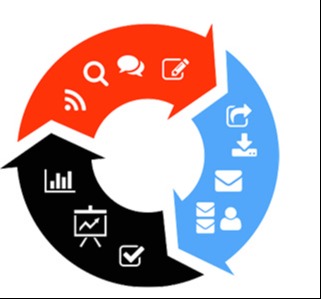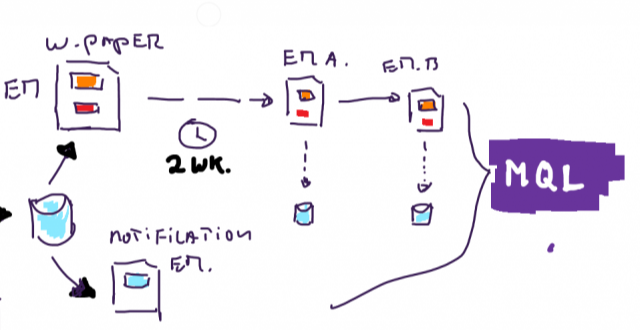B2B sales: scoring customers online the old-fashioned way
When the term "Sales" comes to mind, many people think of pushy B2B salespeople, faulty products and panting advertising messages. Inbound Marketing and Inbound Sales are increasingly taking the place of traditional outbound Marketing and Sales in 2017. This quote from Guy Kawasaki of Apple Computers sums up this development well: "If you have more money than brains, you should focus on outbound marketing. If you have more brains than money, you should focus on inbound marketing." But that is not to say that old sales techniques no longer bring B2B companies success in today's digital age. On the contrary.
According to The Huffington Post, the push strategy has had its day. Highlighting products prominently no longer works. In this digital age, customers search for information on their own and thus no longer depend on a brochure or ad in a trade magazine. The trick for B2B companies is to stand out with content so that customers prospects absorb your information. The trend is that the old-fashioned salesperson is hopelessly dated and a walking cliché. Practice is less adamant.
Sharing knowledge is fun, but ultimately it's all about making a profit. And selling is still very important in that. That this has to be done in a different way than ten years ago seems obvious. The power in the buying process has shifted from seller to buyer. And with that, prospects only enter into contact with an account manager or representative in the last phase of the buying process.
The role of B2B salespeople has changed....
Cold calls and unsolicited house calls are therefore really out of date. But there are still countless ways to market your products. The "old-fashioned" B2B salesman (or woman) still exists, but he or she has taken on a different form with the advent of the Internet and the power that buyers have with it.
His or her job has become easier, because he or she knows (ideally) what his or her customers want. Because customers come in through online channels, the sales person can monitor which buyers are active in the buying process.
Conversely, the same is true because customers are also watching your business and checking it out online. They look around at their own pace and don't ask you for help. Sometimes they don't stay more than a few seconds because your website doesn't appeal to them.
To keep their interest, offering interesting content is amust. Know what you are putting online and what the implications are. A good salesperson knows how to draw attention to their products in an engaging way .
... but old sales techniques still work
A number of B2B salespeople still use old-fashioned sales techniques. With a mixture of bravado, arrogance and guts, they score customersold school style. Online, people are increasingly talking about these individuals.
Old-fashioned sales tricks - sometimes even psychological mind games- are increasingly passing in review. Dated? Maybe, but marketing gurus likeNeil Patelswear by them . Anno 2017, these six techniques are still effective.
6 B2B sales techniques to score online customers the old-fashioned way
Foot-in-the-door technique (FITD) 1.
Thisancient method also works in the digital age. The Foot-In-The-Door Technique (FITD) was introduced in America in the 1960s. Salesmen literally stuck their foot in the door when housewives showed no interest in their vacuum cleaners and wanted to close the door. This "technique" was honed in 1966. With success. Two researchers at American Stanford University discovered that people were willing to grant a bigger favor if they granted a smaller one in return.
This study was conducted several times and the outcome was the same each time. The principle is simple. Ask for something small first and then ask for a bigger favor. In online marketing, this technique works as well. By "something small," think of something like an e-mail address or a Facebook like. If people respond positively to that, they are likely to agree to a download or purchase later.
Face-in-the-door technique 2.
This technique is alsoold school. The trick is to ask something big of the (potential) customer. Startled, he refuses. Then the salesperson suggests a more modest purchase. Chances are the customer will then agree. Itworks. Also online.
If you send an email asking a lead to come to a two-day conference, chances are he'll refuse. If you ask him the following day to watch a half-hour webinar, he's likely to agree. Ambush people and reassure them later by asking "only" a small favor.
' Give me a week' technique 3.
This method increased the likelihood of an interview. You propose a deadline in which you deliver on your promise. You propose to get something done in a certain time frame, proving your reliability. It provides clarity. This is also useful online. "Try this app and notice a difference within a week," is a good example of this strategy.
4. Scarcity technique
By capitalizing on scarcity and time constraints, you trigger the customer's desire to buy. If you don't act now, you willmiss out on a great offer! Online, this method is also great to use. Groupon is good at it. Within a certain time frame you must make a purchase, otherwise the offer expires.
5. Listenpatiently and personalize
Selling is people work. A good salesperson studies his customers, knows what they do and what their background is. In other words, he or she has insight into their pain points and challenges. You use this information in a personalized conversation.
Admit it: you'd rather buy something from someone who calls you by name than an impersonal salesperson, wouldn't you? By listening patiently and tapping into common interests, you create a connection.
Visit your customer. Introduce yourself and let them know who they will be doing business with. You are now more than an email or blog. Chances are this lead will turn into a customer.
6. Pick up the phone
For decades, the phone was the weapon of the B2B salesperson. And while it may seem like the phone has been replaced by social media and email in 2017, nothing could be further from the truth. Calling is useful.
If you don't reach someone with your tweets or blogs, thegood old phone will help you out. By striking up a conversation, you know exactly where the customer stands.
The modern B2B salesperson is online and takes a personal approach
The above techniques are old school, but still work when combined with today's insights. The modern (old-fashioned) B2B salesperson is persistent, but not pushy. He is shrewd but not underhanded. The biggest difference between the old school and new school B2B salesman is presentation. The old school salesman comes out bluntly that he wants to make a profit. Modern marketers and sales persons want that too, of course, but focus on helping.
Another difference is that while the modern B2B salesman is online, he prefers to take a more personal approach, also called Inbound Sales. 'Old-fashioned' salespeople are ineradicable. It's their profession. But they do move with the times to remain successful.

Want to get the most out of HubSpot? Subscribe to our newsletter, follow us on LinkedIn, or attend our HubSpot User Days!
Explore HubSpot User DaysShare this
You May Also Like
These Related Stories

An efficient B2B marketing strategy in 3 steps

Lead generation in B2B: Generating leads effectively, how?


